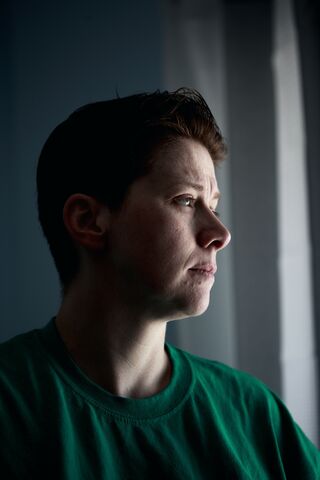Health
One of the Largest Health Issues Facing LGBTQ+ People Today
What professionals can do to prevent it.
Posted November 1, 2022 Reviewed by Vanessa Lancaster
Key points
- LGBTQ-related intimate partner violence (IPV) is one of the largest health issues facing the LGBTQ+ population occurring in every 1 in 3 people.
- Only two court-approved LGBTQ-specific batterers' intervention programs exist in the U.S., and zero LGBTQ+ domestic violence shelters.
- Professionals must learn the four categories specific to LGBTQ+ relationships to prevent LGBTQ-related IPV.

Four years ago, I was hired to provide LGBTQ-inclusivity training to the staff at a domestic violence shelter in Los Angeles.
When I arrived to get a tour of the facility, one of the clinicians shared a story with me that I’ll never forget. She told me about a young woman who came in seeking services from an abusive relationship. The young woman had been battered and needed help.
When the intake counselor made a heterosexist assumption (when we conceptualize a person’s identity in heterosexual terms) and asked her for details about her boyfriend, the young woman shut down and stopped talking. At the time, the staff didn’t realize the young woman was a lesbian and that she was in an abusive relationship with her girlfriend.
For survivors of domestic violence, or intimate partner violence (IPV), it takes a great deal of courage to reach out and ask for help. When a person finally does decide to get help, they often have to contend with the shame they feel about being in an abusive relationship. Not only did the young woman seeking services that day have shame for being in an abusive relationship, but her shame was compounded by having to disappoint the counselor’s heterosexist expectations.
Before she left that day, the young woman did eventually tell the staff she was a lesbian and that her abuser was her girlfriend. However, she never returned. Her story demonstrates one key reason why LGBTQ-related IPV is one of the largest health issues facing the LGBTQ+ population—occurring in every 1 in 3 people.
Due in large part to the shame and stigma surrounding both IPV and anti-LGBTQ+ bias, including internalized homophobia or internalized transphobia, LGBTQ+ IPV doesn’t get the attention it deserves. And because domestic violence is thought to occur most commonly in heterosexual relationships, members of LGBTQ+ communities may not even realize that they are experiencing IPV.
Although the rates of IPV in heterosexual relationships are similar to those of LGBTQ+ IPV, the key difference is that LGBTQ+ IPV always occurs against a backdrop of anti-LGBTQ+ bias.
What’s more, LGBTQ+ people who are in abusive relationships may believe, consciously or unconsciously, that they deserve to be abused as punishment for their sexual orientation or gender identity—remnants of internalized queerphobia that, left unaddressed, continue to cause harm in the lives of LGBTQ+ people and their relationships.
For almost 12 years, I bartended at a popular gay bar in West Hollywood, CA. I witnessed many co-workers–whether gay men, lesbian women, or trans—fight with their partners throughout the years.
One man, a partner in a gay couple, often came to work with bruises on his body. One night, before beginning our shift a few years ago, I walked into the employee bathroom and saw him applying concealer to a fresh black eye. At the time, it didn’t occur to me that his bruises were evidence of IPV. It pains me to admit this today, but I didn’t think that two handsome, young, popular gay men would physically abuse one another.
Unfortunately, neither did the other staff where I worked. The two young men were glorified for their good looks, and the abuse continued to go unnoticed. Whether it was denial or benign neglect, my unawareness of my co-workers’ abusive relationship speaks to the two most common myths that keep LGBTQ+ IPV alive: women can’t be abusers, and men can’t be abused.
Something else that keeps LGBTQ+ IPV alive is a lack of education surrounding LGBTQ-related IPV. In a 2021 interview celebrating the 25th anniversary of the STOP Violence Program at the Los Angeles LGBT Center–the nation’s largest and most comprehensive LGBTQ-specific program of its kind–Dr. Susan Holt, Program Manager of the STOP Violence program, said,
LGBTQ domestic violence is not the same as domestic violence in the heterosexual community. There are significant differences. If you don’t understand those differences, then you’re not going to be helpful, or even safe, as a service provider for those who need help.
What Professionals Need to Know About LGBTQ+ IPV
To begin, the three main causes of LGBTQ-related IPV for mental health professionals to be aware of are:
1. Internalized queerphobia.
Internalized queerphobia is when we introject shameful messages we learn as children about what it means to be LGBTQ+ (See “The Clinical Implications of ‘Internalized Queerphobia’”). If any of us, queer or non-queer, has shame, we may unconsciously seek punishment or project our shame onto another person. This could look like many things, but for understanding LGBTQ-related IPV, it specifically highlights why some survivors stay in abusive relationships and why some abusers abuse.
2. Heterosexism and barriers to seeking help.
Heterosexism–the belief that being heterosexual and cisgender is the only normal and natural sexual orientation and gender identity–informs everything from the legal definitions of domestic violence that influence laws and intake questions to assumptions made by professionals and the perceptions we have of both survivors and abusers. At its core, heterosexism erases LGBTQ+ relationships.
3. Anti-LGBTQ+ bias.
Anti-LGBTQ+ bias creates societal stigma toward LGBTQ+ people. As it relates to LGBTQ+ IPV, this looks like not having a single LGBTQ+ domestic violence shelter in the United States. In fact, there are only two court-approved LGBTQ-specific batterers' intervention programs in the U.S.
In comparison, there are approximately 150 court-approved batterers’ intervention programs in Los Angeles County alone. What’s problematic about not having LGBTQ+ domestic violence shelters is that lesbian abusers are inadvertently sheltered with survivors, and transgender survivors are often denied shelter anywhere.
Prevention as an Effective Form of Treatment
In order to prevent LGBTQ-related IPV, among many things, it’s vitally important that mental health professionals first understand the categories specific to LGBTQ+ relationships put forth by Dr. Holt’s groundbreaking work:
- Primary aggressor: Someone whose goal is to maintain power and control. This could be through physical, mental, emotional, sexual, and/or financial means.
- Secondary aggressor: This is a common category in LGBTQ+ relationships. It’s often seen as a mutual conflict, but a primary aggressor is a person who fights back in self-defense or retaliation. What makes this person an “aggressor” at all, however, is that they don’t disengage once a conflict has subsided.
- Primary victim: A person who seeks to disengage from any conflict as quickly as possible. There’s no fighting back in retaliation or defense.
- Defending victim: This is another common category for members of the LGBTQ+ community. Most members of the LGBTQ+ community have had to defend themselves, whether in school, at home, or on the playground. After a conflict begins, a “defending victim” will fight back in self-defense. However, once a person feels as though they’ve defended themselves or have established a sense of safety, they disengage.
Some important things to note:
- According to Dr. Holt, the two most common categories that clinicians and mental health professionals will see are defending victims and secondary aggressors.
- Primary aggressors typically don’t seek out mental health services–even though they need just much, if not more, help than survivors–which is why they aren’t as common of a category that professionals will see.
- Individual therapy is contraindicated for abusers, and couples therapy is contraindicated for partners (Ford et al., 2012).
The best intervention mental health professionals can use to help address LGBTQ-related IPV is to learn more about it. And the best way we can prevent LGBTQ-related IPV from continuing to be one of the largest and most serious health issues facing the LGBTQ+ community today is by healing its cause.
For additional information:
Domestic Violence Services at the Los Angeles LGBT Center
Finding Safety: A Report About LGBTQ Domestic Violence and Sexual Assault
If you think that someone may need help, here is the National Domestic Violence Hotline.
To find a therapist near you, visit the Psychology Today Therapy Directory.
References
Ford, C. L., Slavin, T., Hilton, K. L., & Holt, S. L. (2012). Intimate Partner Violence Prevention Services and Resources in Los Angeles. Health Promotion Practice, 14(6), 841–849. https://doi.org/10.1177/1524839912467645
Mental Health America of Northern California and Equality California Institute, prepared for the California Department of Public Health Office of Health Equity. (2012). First, Do No Harm: Reducing Disparities for Lesbian, Gay, Bisexual, Transgender, Queer and Questioning Populations in California, The California LGBTQ Reducing Mental Health Disparities Population Report. https://lhc.ca.gov/sites/lhc.ca.gov/files/Reports/225/ReportsSubmitted/…
Messinger, A. M. (2020). LGBTQ Intimate Partner Violence: Lessons for Policy, Practice, and Research (First ed.). University of California Press.
National Resource Center on Domestic Violence. (2007). Lesbian, gay, bisexual & transgender (LGBT) communities and domestic violence: Information & resources. Harrisburg, PA: Pennsylvania Coalition Against Domestic Violence.
The Center’s Revered STOP Violence Program Turns 25. (2021, October 14). LGBT News Now. https://lgbtnewsnow.org/the-centers-revered-stop-violence-program-turns…




